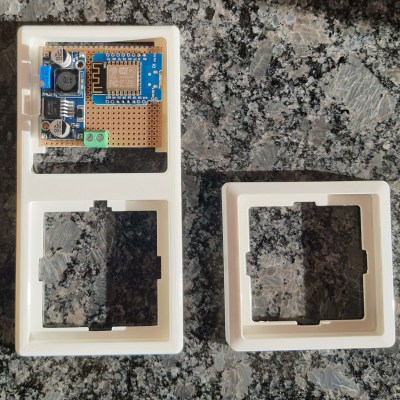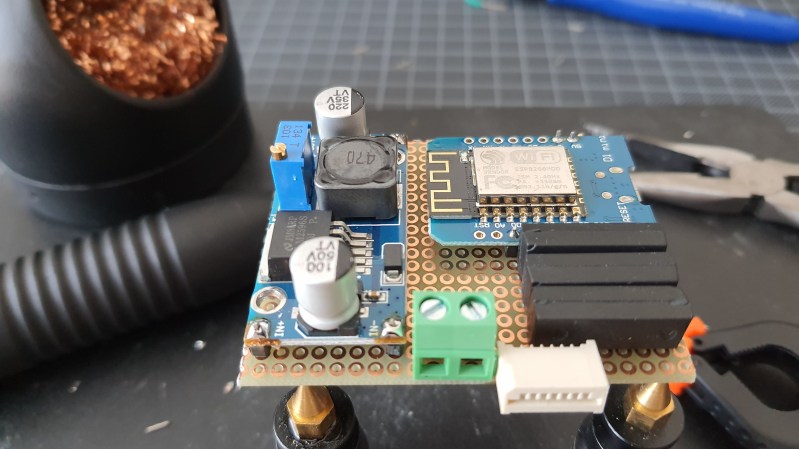When a person owns the home they live in, often the only approval they need for modifications is from their significant other or roommate. In the worst case, maybe a permit is required. But those who rent their dwellings are far more constrained in almost every case, and when it comes to environmental controls, they are most decidedly off limits. Unless you’re a resourceful hacker like [Nik], that is, who has seamlessly integrated his apartment’s ventilation system into his smart home controller — all without any permanent modifications!
The controller itself only gives three settings to vent the apartment: Low, Medium, High, and then High for 30 minutes, with all modes having to be actuated with a manual button press. [Nik] wanted automation and integration with his smart home.

Thankfully, the engineers who designed the controller used in [Nik]’s apartment made it very convenient to reverse engineer it. A flat ribbon cable conveniently breaks out all of the buttons and 12 VDC, and he can interface directly using its connector. First hack: done.
Next, [Nik] needed a longer cable to run between the controller and his ESP8266 based control module. Finding the connector on AliExpress was easy, but finding a compatible cable of length required some more resourcefulness. The cable was eventually sourced from the airbag controller of a Renault Megane! Second hack, using a car part in a controller: well done!
Integration into his smart home wasn’t just electronic. The module looks right at home above the original controller, and if you didn’t know better you’d never think it wasn’t original equipment. Final hack: Done!
Be sure to check out his build log over at Hackaday.io, and if home automation hacks are your cup of tea, check out this automatic tea maker.















This is a cool hack. I know this is hackaday not buy some thing a day. But I may suggest using some kind of “Button pusher” or “Switch bot” if the electrical access is not possible or simply being lazy to make a circuit.
Unfortunately, such solutions tend to yield a wife acceptance factor of way below zero.
Is that a BUVA fan controller? If yes, let me know! I reverse engineered the radio protocol they use long ago and created a gateway also using a ESP32. :)
That would have been the better solution. Unfortunately it is not a BUVA controller. There are antennas, but I don’t have a remote control for them.
Not an expert, but afaik, there were several ventilation system brands working under the same HW. Your controller looks VERY similar to mine so might be there is some room for luck… is it possible for you to take a picture of the guts of the ventilator so I can see the control board? or if not possible, please look for a NRF905 chip on it, and let me know.
I looked at the controller again, there is an NRF905 on the board. Do you think I could control it with your ESP32 Gateway?
Seems you are lucky, most likely YES you can control it via radio. And most likely the controller you’ve hacked is already using radio. How can I contact you?
I’ve sent you some private messages on your hackaday.io profile with details.
That would be the better solution. Unfortunately it is not a BUVA controller. I also saw antennas in the case, but I don’t have a remote control for them.
Really just put that up on Github (or a similar service). I may not need it but someone else will need to ‘scratch that itch’. :-)
Yep, planning to do it ASAP, is just I didn’t find the time to do it yet. I just want to document the whole thing rather than simply uploading undocumented code.
That would have been the better solution. Unfortunately it is not a BUVA controller. Mine can also be controlled remotely (I assume since I saw antennas) Unfortunately I don’t have a remote control for it.
I wish articles included the blog thumbnail at a larger size. I hate when I can see the whole finished project (although small) until I click to read, then I can’t see it unless I go back and squint at a thumbnail.
Check the linked hackaday.io project, it has all the full size images for you :)
Nik – very nice. That’s given a few ideas. :-)
I’m guessing you live outside of the USA where virtually all HVAC units use 24 VAC for control.
Yes, i’m from Switzerland. with the “LM2596 ” DC-DC stepdown converter, 24V would not be a problem either.
In my apartment dwelling days I don’t think I ever worried about this. They always came with those cheap, basic mechanical thermostats. I would move in, swap that out for a programmable digital one and chuck the original in the back of a drawer. When it would come time to move out I’d swap them back again. I remember that being common. Lot’s of my college friends did this. I never asked first. We would have maintenance people in the apartment to fix this and that and nobody ever seemed to notice or care.
I also did things like replace any worn power outlets that plugs fell out of easily. When we had land lines they would often be painted over by the maintenance people. Same with the cable tv jacks. I’d replace them myself rather than wait for the landlord to do it. If the line was only in one room I’d remove the wall plate, poke a hole through to the room behind it and use that hole to mount a second jack on the other side of the wall.
Actually, I’d usually replace the wall plate with one that was telephone landline, cable tv AND ethernet. Then when I poked the hole through to the other side I’d have Ethernet on that plate too and connect the two jacks together. This way I could run Ethernet through the wall without looking like I made a hole.
Where there weren’t existing jacks on the wall I wanted to pass through like this I would just drill a hole in an out-of-site corner. Shaggy carpets were the best for this because I could press the carpet down and make the hole so low that when I go to move out and remove the wire it springs back up and most of the hole is covered by the carpet.
I never had a complaint from a landlord and I always got my full deposit back.
As a landlord myself today when my tenants do these things I don’t really mind. The only time I do mind is if they aren’t checking first and re-using the holes previous tenants made and so the holes multiply unnecessary.
That’s the same controller my HRV uses (it’s a Zehnder Comfo-air 350), I have had to dismantle the controller a couple of times (it uses a coin cell for backup power, but it’s flakey about restarting after power outages). I can imagine it would be pretty doable to patch into it this way, but it’s also something I rarely ever adjust, but build looks clean!
Thanks. In my apartment there are several ventilation openings in every room. for this reason i use the ventilation every day. I no longer open the windows (in winter because of too much heat loss, in summer because of the insects)
You’re gonna need a 27B-6 for fitting one of those.
Failure to do so may result in a visit from Central Services…
Implementing home automation in a rented property is challenging in interesting ways. I used to build a “water heater knob turning device” once, to noninvasively control my water heater. With the right hacker spirit, there is always a way :-D
I recall an apartment with hot-water baseboard heating that was set up to keep the cost of heat down for the apartment owners. The thermostat was and old mercury switch type mounted on a wall above one of the baseboard heat sources. The result was that no matter how high you set the temperature it would never go above 63F/17C.
So I bought the cheapest radio controlled relay with remote that I could find and rummaged through my parts on hand. An old dial-type mercury thermostat, an Arduino, and the remote cobbled together let me put my thermostat anywhere I wanted in the apartment using old phone chargers as power for the remote T-stat and the relay. A few more dollars for a cheap wood frame from the hobby store and it actually looked nice.
As the existing thermostat was left in place the apartment management never noticed during their annual inspection and we could set the heat to a more comfortable temperature.
I did a similar thing, but since the fans used a regular 3 kHz pwm signal I put an esp32 and a bunch of optocouplers together and control the fans directly. The esp is stored in a wall box where I can conveniently leach off power from the fans for the controller. Now I can control each fan individually and make them react to other sensors, ie turn on thru ventilation when the apartment gets above the set temperature and the outside temperature is lower than inside
You think this is cool you should have seen what I did at my first place. It was a house and the landlord kept the ac at a hot 74 and seeing as my room was far away from the actual unit my room was easily 76 which made it hard to sleep. He rented the rooms out individually which allowed him access to the house at all times and he lived down the street so he would keep tabs to make sure we didn’t turn the temp up or down..
I had access to the basement and the Ethernet cables to my room so happened to run by the wires running from the thermostat to the ac unit. Spliced into the Ethernet cables and the thermostat wires, used a couple relays and diodes to connect them together safely and unplugged the end going into the router of course. Made myself a special wire by attaching a switch to an eithernet cable, plugged it in and I could turn on the ac whenever I wanted even after he installed a lock box.
Yes I uninstalled it properly when I left.